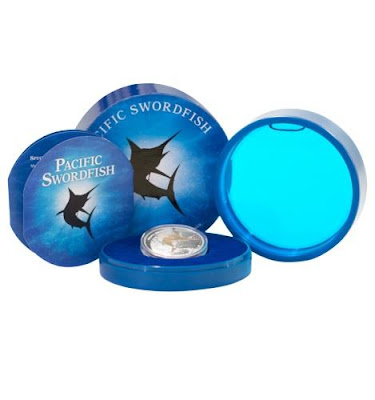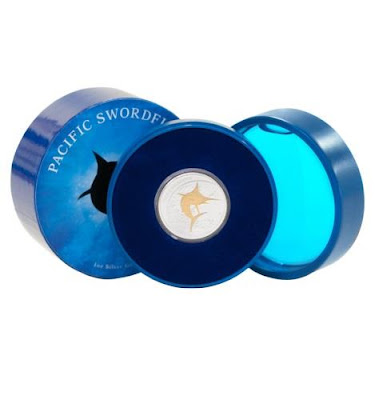Fiji 2 Dollars Gilded Silver Coin 2011 Pacific Swordfish
This magnificent sea creature is the subject of New Zealand Mints latest coin issue.
Obverse: The obverse of the coin features the Raphael Maklouf effigy of Her Majesty Queen Elizabeth II, and denomination of Fiji $2.
Reverse: This features a Pacific Swordfish swimming through the waters of the Pacific Ocean along with an engraved heading and the metal quality and weight of the coin.
Packaging: No more than 5000 Swordfish gilded silver coins will be issued by New Zealand Mint. The coin comes encapsulated in a striking cylindrical display case with a transparent lid filled with aquamarine liquid.
Face Value: 2 Dollars.
Metal: Silver.
Fineness: .999.
Weight: 1 Oz (31.10g).
Diameter: 40.50 mm.
Edge: Milled.
Mintage: 5000 pcs.
Finish: Prooflike.
Swordfish
Swordfish (Xiphias gladius; from Greek ξίφος: sword, and Latin gladius: sword), also known as broadbills in some countries, are large, highly migratory, predatory fish characterized by a long, flat bill. They are a popular sport fish of the billfish category, though elusive. Swordfish are elongated, round-bodied, and lose all teeth and scales by adulthood. These fish are found widely in tropical and temperate parts of the Atlantic, Pacific, and Indian Oceans, and can typically be found from near the surface to a depth of 550 m (1,800 ft). They commonly reach 3 m (9.8 ft) in length, and the maximum reported is 4.55 m (14.9 ft) in length and 650 kg (1,430 lb) in weight.
They are the sole member of their family, Xiphiidae.
Taxonomy
The swordfish is named after its bill resembling a sword (Latin gladius). This makes it superficially similar to other billfish such as marlin, but upon examination, their physiology is quite different and they are members of different families.
Description
They commonly reach 3 m (9.8 ft) in length, and the maximum reported is 4.55 m (14.9 ft) in length and 650 kg (1,430 lb) in weight. The International Game Fish Association's all-tackle angling record for a swordfish was a 1,182 lb (536 kg) specimen taken off Chile in 1953. Females are larger than males, and Pacific swordfish reach a greater size than northwest Atlantic and Mediterranean swordfish. They reach maturity at 4–5 years of age and the maximum age is believed to be at least 9 years. The oldest swordfish found in a recent study were a 16-year-old female and 12-year-old male. Swordfish ages are derived, with difficulty, from annual rings on fin rays rather than otoliths, since their otoliths are small in size.
Swordfish are ectothermic animals; however, along with some species of sharks, they have special organs next to their eyes to heat their eyes and brains. Temperatures of 10 to 15 °C above the surrounding water temperature have been measured. The heating of the eyes greatly improves their vision, and consequently improves their ability to catch prey. Of the 25,000+ fish species, only 22 are known to have a mechanism to conserve heat. These include the swordfish, marlin, tuna, and some sharks.
Behavior and ecology
Contrary to popular belief, the "sword" is not used to spear, but instead may be used to slash at its prey to injure the prey animal, to make for an easier catch. Mainly, the swordfish relies on its great speed and agility in the water to catch its prey. It is undoubtedly among the fastest fish, but the basis for the frequently quoted speed of 97 km/h (60 mph) is unreliable.
Swordfish prefer water temperatures between 18 and 22 °C (64 and 72 °F), but have the widest tolerance among billfish, and can be found from 5 to 27 °C (41 to 81 °F). This highly migratory species typically moves towards colder regions to feed during the summer. Swordfish feed daily, most often at night, when they rise to surface and near-surface waters in search of smaller fish. During the day, they commonly occur to depths of 550 m (1,800 ft) and have exceptionally been recorded as deep as 2,878 m (9,442 ft). Adults feed on a wide range of pelagic fish, such as mackerel, barracudinas, silver hake, rockfish, herring, and lanternfishes, but they also take demersal fish, squid, and crustaceans. In the northwestern Atlantic, a survey based on the stomach content of 168 individuals found 82% had eaten squid and 53% had eaten fish, including gadids, scombrids, butterfish, bluefish, and sand lance. Large prey are typically slashed with the sword, while small are swallowed whole.
Swordfish are not schooling fish. They swim alone or in very loose aggregations, separated by as much as 10 m (33 ft) from a neighboring swordfish. They are frequently found basking at the surface, airing their first dorsal fin. Boaters report this to be a beautiful sight, as is the powerful jumping for which the species is known. This jumping, also called breaching, may be an effort to dislodge pests, such as remoras or lampreys.
Almost 50 species of parasites have been documented in swordfish. In addition to remoras, lampreys, and cookiecutter sharks, this includes a wide range of invertebrates, such as tapeworms, roundworms, and copepods. A comparison of the parasites of swordfish in the Atlantic and in the Mediterranean indicated that some parasites, particularly Anisakis spp. larvae identified by genetic markers, could be used as biological tags and support the existence of a Mediterranean swordfish stock.
Except for humans, fully adult swordfish have few enemies. Among marine mammals, killer whales sometimes prey on adult swordfish. The shortfin mako, an exceptionally fast species of shark, sometimes take on swordfish; dead or dying shortfin makos have been found with broken-off swords in their heads, revealing the danger of this type of prey. Juvenile swordfish are far more vulnerable to predation, and are eaten by a wide range of predatory fish.
Breeding
In the North Pacific, batch spawning mainly occurs in water warmer than 24 °C (75 °F) during the spring and summer, and year-round in the equatorial Pacific. In the North Atlantic, spawning is known from the Sargasso Sea, and in water warmer than 23 °C (73 °F) and less than 75 m (246 ft) deep. Spawning occurs from November to February in temperatures above 20 °C (68 °F) in the South Atlantic off southern Brazil. Spawning is year-round in the Caribbean Sea and other warm regions of the west Atlantic.
Large females can carry more eggs than small females, and between 1 million to 29 million eggs have been recorded. The pelagic eggs measure 1.6 – 1.8 mm (0.063–0.071 in) in diameter and 2.5 days after fertilization, the embryonic development occurs. The surface-living and unique-looking larvae are 4 mm (0.16 in) long at hatching. The bill is evident when the larvae reach 1 cm (0.39 in) in length.
Fisheries
Swordfish have been fished widely since ancient times, among others in the sea between Sicily and Calabria, such as off the Tyrrhenian coast in the Reggio Province. It is a typical dish in the cuisine of this region.
Swordfish were harvested by a variety of methods at small scale (notably harpoon fishing) until the global expansion of long-line fishing.
Swordfish are vigorous, powerful fighters. When hooked or harpooned, they have been known to dive so quickly, they have impaled their swords into the ocean bottom up to their eyes. Although no unprovoked attacks on humans have been reported, swordfish can be very dangerous when harpooned. They have run their swords through the planking of small boats when hurt. In 2015, a Hawaiian fisherman was killed by a swordfish after attempting to spear the animal.
Recreational fishing
Recreational fishing has developed a subspecialty called swordfishing. Because of a ban on long-lining along many parts of seashore, swordfish populations are showing signs of recovery from the overfishing caused by long-lining along the coast.
Various ways are used to fish for swordfish, but the most common method is deep-drop fishing, since swordfish spend most daylight hours very deep. The boat is allowed to drift to present a more natural bait. Swordfishing requires strong fishing rods and reels, as swordfish can become quite large, and it is not uncommon to use five pounds or more of weight to get the baits deep enough during the day, up to 2000 ft is common. Night fishing baits are usually fished much shallower, often less than 90 metres (300 ft). Standard baits are whole mackerel, herring, mullet, bonito, or squid; one can also use live bait. Imitation squids and other imitation fish lures can also be used, and specialized lures made specifically for swordfishing often have battery-powered or glow lights. Even baits are typically presented using glow sticks or specialized deepwater-proof battery operated lights.
As food
Swordfish are classified as oily fish. Many sources, including the United States Food and Drug Administration, warn about potential toxicity from high levels of methylmercury in swordfish. The FDA recommends that young children, pregnant women, and women of child-bearing age not eat swordfish. (See mercury in fish for more details.)
The flesh of some swordfish can acquire an orange tint, reportedly from their diet of shrimp or other prey. Such fish are sold as "pumpkin swordfish", and command a premium over their whitish counterparts.
Swordfish is a particularly popular fish for cooking. Since swordfish are large animals, meat is usually sold as steaks, which are often grilled. Swordfish meat is relatively firm, and can be cooked in ways more fragile types of fish cannot (such as over a grill on skewers). The color of the flesh varies by diet, with fish caught on the East Coast of North America often being rosier.


